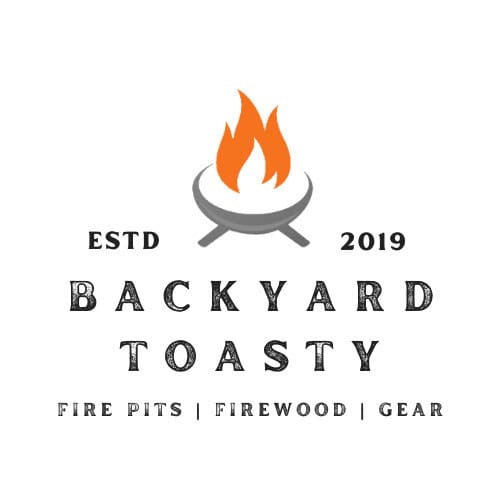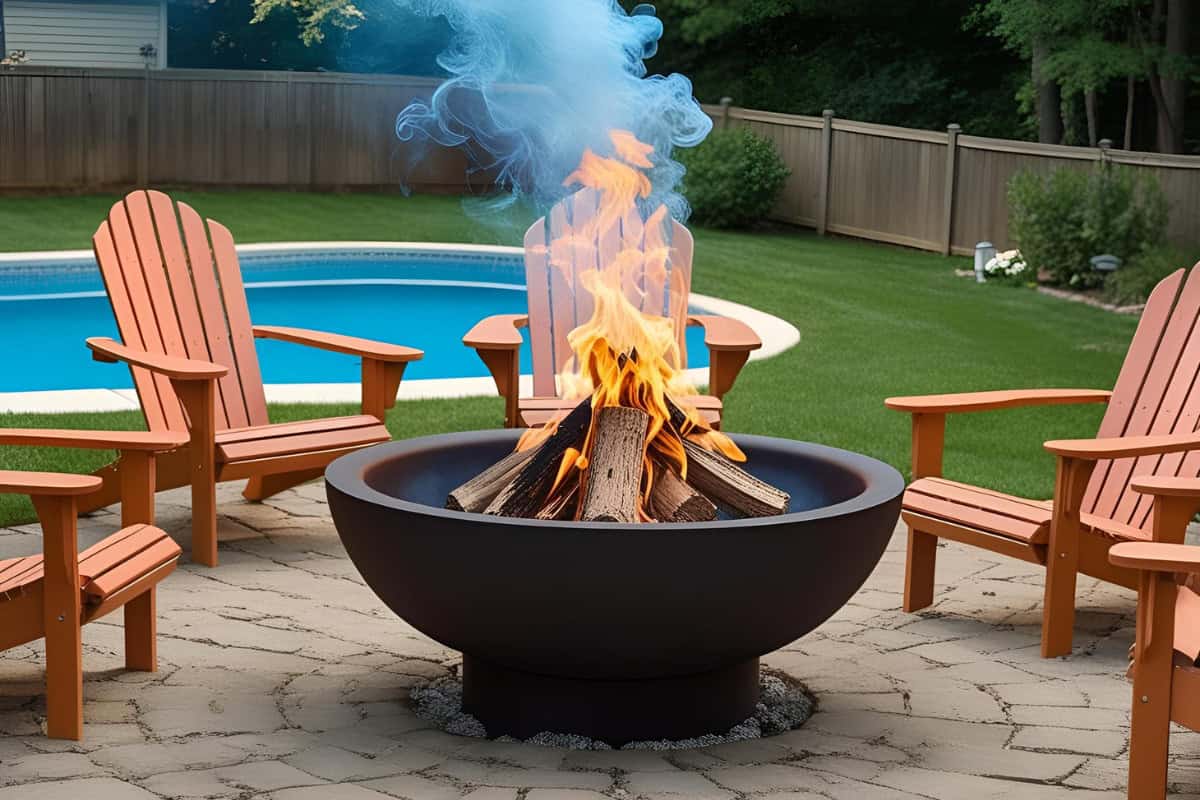
To reduce fire pit smoke, it’s important to understand the causes of one of the most common and fixable backyard fire pit problems.
To reduce fire pit smoke, always use properly seasoned firewood with moisture content below 20%. Freshly cut wood contains excessive moisture that creates smoke during burning and prevents efficient combustion. Unseasoned wood burns at lower temperatures, resulting in incomplete combustion and increased smoke production. A moisture meter can help verify your wood is properly dried before use.
In this article, we’ll get to the bottom of what causes it and what you can do to minimize annoying smoke before your next backyard gathering around the fire.
The burning of wood types that contain pitch/sap and other naturally occurring substances can also be a factor in excess fire pit smoke production.
Improper stacking of wood during the fire building process that causes fuel to smoke instead of burn can also contribute to the amount of smoke you may experience.
Pick the right dry wood that doesn’t smoke much. This will keep your guests from constantly moving around the fire pit.
I’ll explore dry wood characteristics and which types smoke least. We’ll also look at how fire pit makers are reducing smoke.
Let’s begin…
- What I've Learned About Eliminating Fire Pit Smoke
- 5 Ways to Reduce Fire Pit Smoke
- 1. Use Well Seasoned or Kiln-Dried Firewood
- 2. Focus on Using Firewood Types That Naturally Smoke Less
- 3. Take the Time to Build a Fire That Starts Quickly and Burns Long
- 4. Keep Your Fire Pit Clean After Every Use to Reduce Fire Pit Smoke
- 5. Consider Using a Smokeless Fire Pit to Drastically Reduce Fire Pit Smoke
- Smokeless Fire Pits: The Current Market
- Wrap-up: Reduce Fire Pit Smoke
- FAQs: Reduce Fire Pit Smoke
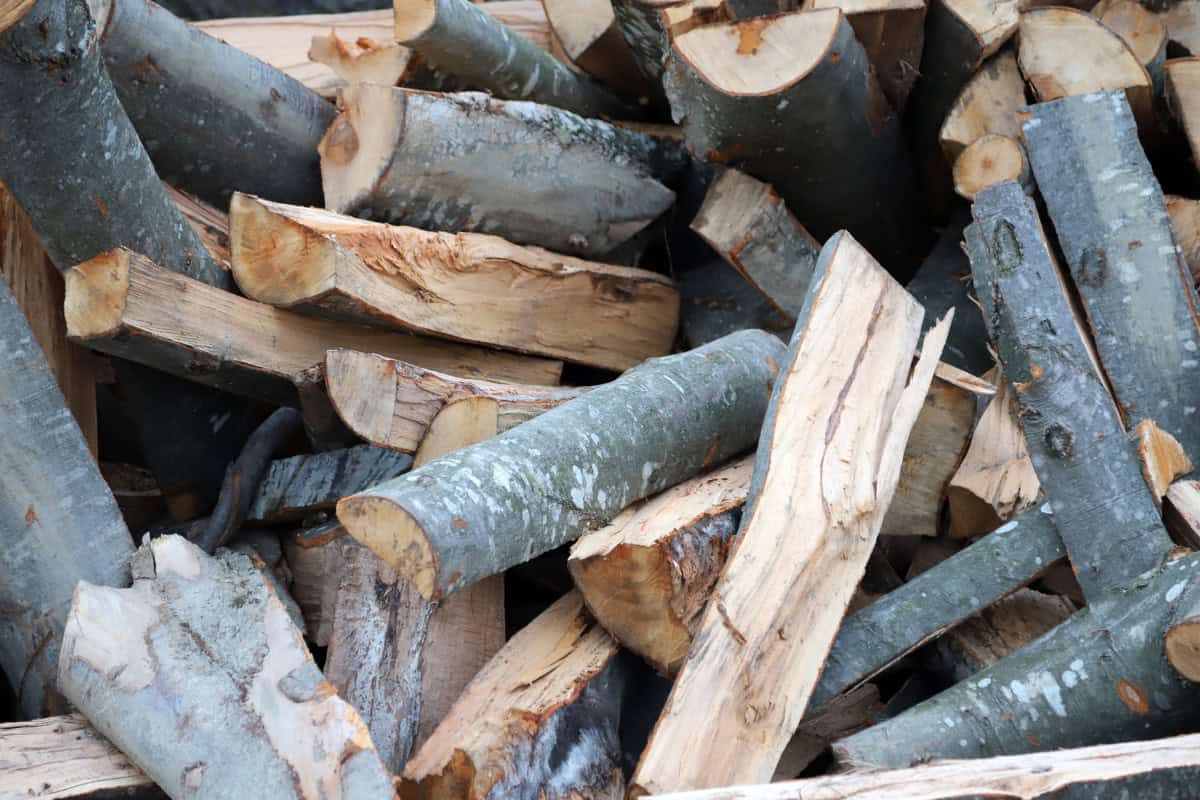
What I’ve Learned About Eliminating Fire Pit Smoke
Wood smoke comes from burning chemicals in hardwoods like oak and softwoods like pine.
Poor heating turns these chemicals into smoke around your fire pit.
Efficient fires burn these chemicals quickly, producing less smoke.
An efficient, well-burning fire quickly consumes these chemicals before they can form significant amounts of smoke.
There are other contributors, but this is the most likely cause of most wood smoke.
Smoke from Green or Improperly Seasoned Firewood
Long story short, seasoned wood is firewood with a moisture content of at least 20%; the lower, the better.
Wood achieves ideal moisture through natural aging outdoors/indoors or faster, more expensive kiln drying.
The bottom line is that dry wood burns efficiently and as a result, it doesn’t smoke a lot.
Freshly cut wood, or “green” wood, contains mostly water. This high moisture content prevents the wood from burning efficiently, causing it to produce excessive smoke.
Even old, previously cut wood burns poorly when consistently exposed to moisture, preventing proper drying.
Check my article Best Burning Firewood for Your Fire Pit for seasoning specifics.
Well-seasoned firewood feels lighter, sounds hollow when struck, has no smell, and often shows a grayish tint.
You can easily track wood moisture levels with an inexpensive handheld moisture meter, available at your local hardware store.
Firewood needs 20% moisture content at minimum, but 20% or less is ideal—kiln-dried wood typically meets this standard.
For maximum smoke reduction, using the right firewood with proper moisture content delivers the best results.
More on kiln-dried firewood later on in the article.
Other Causes of Excess Fire Pit Smoke
In addition to moisture, there are a variety of other drivers that could be the culprit if you are having regular trouble with fire pit smoke.
Some of the following, combined with high moisture, could already be making your recent fire pit burns a smoky mess.
Debris Buildup in Your Fire Pit
Old and potentially damp ash, embers, and other debris that has accumulated in your fire pits from recent burns could slow the ignition of your current fire, resulting in a fire pit they not only won’t catch but will smoke a lot as you stumble around trying to figure out what to do.
Firewood with High Pitch (Sap) Content.
Growing up in a rural, heavily wooded area in Southern New Jersey (Cape May County) I remember there was always a standing “rule” against burning pine.
I now believe the concerns I learned as a child likely related to fireplace use, and even then, I’m not certain those concerns are entirely warranted.
The belief was that pine and other softwoods gummed up your chimney quicker than other types of wood.
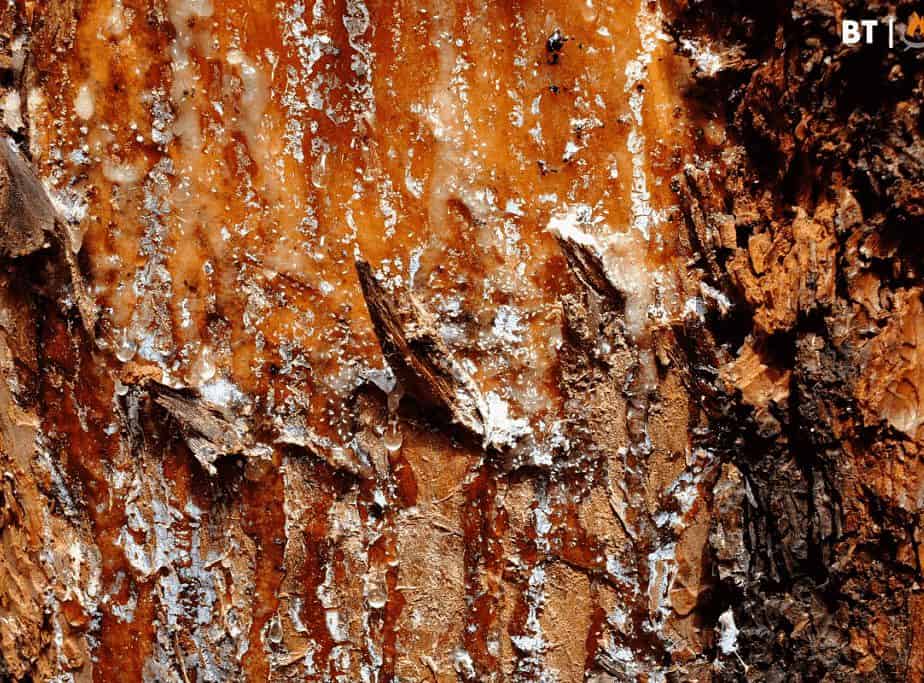
The high sap content of these wood types makes this sound logical, but I remain somewhat skeptical.
Anyway, softwoods like pine, juniper, balsam, spruce, etc. can burn very hot for short periods of time, making them good firestarter wood.
That said, when burned, these wood types with air-hardened pitch can produce significant amounts of smoke.
In fact, people have used “fatwood” from pine tree heartwood as a firestarter for hundreds of years.
The hardened tree sap in fatwood contains a high concentration of terpene, which ignites quickly and helps start the rest of the fire.
You can find fatwood at your local hardware store or firewood vendors, and from a handful of online sellers.
If you are interested in finding your own fatwood out in nature, this is a very good tutorial on how to do it at Instructables.
What is terpene? Terpene is the naturally occurring flammable chemical in tree sap that makes pines and other softwood wood types excellent firestarter wood.
Bottom line, split softwoods aren’t always the best choice for your main firewood source. They can smoke excessively plus, they don’t burn for a long time.
Well-seasoned softwoods can work if your options are few but understand the limitations.
Improper Stacking of Firewood in Fire Pit
A key component to building a quick-starting long-burning fire is good airflow.
Simply tossing logs and kindling into your pit often results in smoldering fuel rather than a proper fire.
A teepee or log cabin firewood stack will keep air flowing and provide housing of sorts for your tinder and kindling – see the example below.
Take some time to do this right because all you will have is smoke and no fire. See the images below for an example.
Burning of Green Pine Needles, Pinecones, Tree Bark, Etc.
Sometimes it makes sense to collect debris from the forest floor to use as kindling, tinder, etc. By debris, I mean pine needles, pine cones, tree bark, etc.
If using these fire starters, ensure everything is completely dry with no green material present.
This kind of debris will smoke excessively if it hasn’t had a chance to dry out.
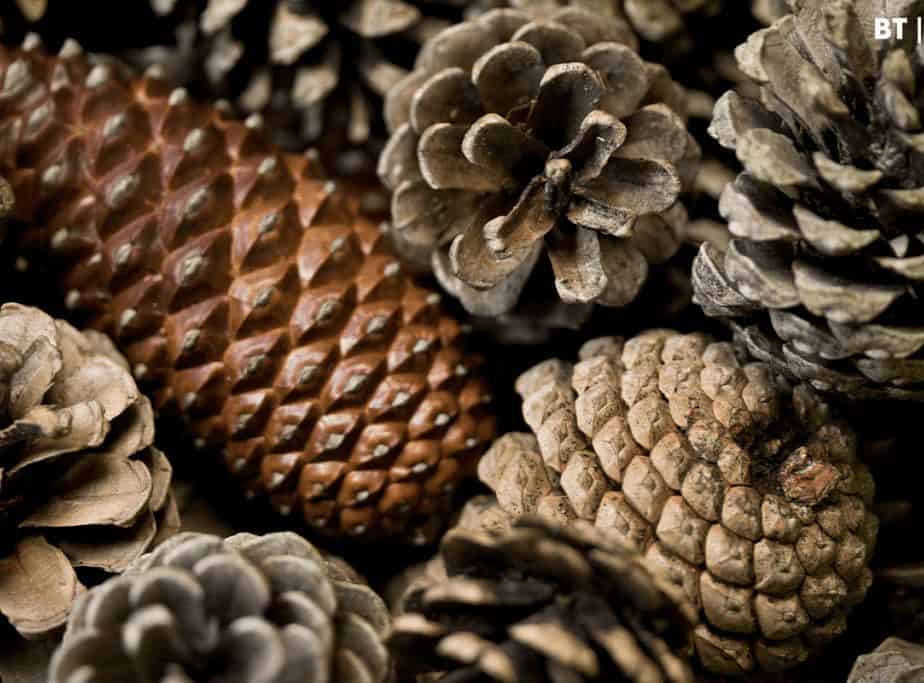
Burning Household Waste in a Fire Pit
Certain types of treated cardboard will smoke heavily when burned in a fire.
Beyond smoke, you’ll face potentially unhealthy fumes that could harm you and your family.
Stick to tinder, kindling, and firewood in the fire pit. A little newspaper at the beginning of the fire to get things going is ok.
Don’t stuff a week’s worth of papers on a fire that just won’t start to help it along. It’s probably something else keeping it from catching.

5 Ways to Reduce Fire Pit Smoke
Let’s explore how to apply this knowledge to minimize smoke during your next fire pit session.
Let’s explore how to apply this knowledge to minimize smoke during your next fire pit session.
These action steps and pointers address several smoke-reducing strategies that you can use individually or in combination with each other:
1. Use Well Seasoned or Kiln-Dried Firewood
As we covered above, wet wood is bad when trying to keep fire pit smoke down. Using adequately dried wood will produce much less smoke and perform much better for a longer time.
Seasoned (Air-Dried) Firewood for Fire Pits.
I recommend hardwoods over softwoods when chopping your own firewood, as they produce less smoke.
Hardwoods require longer seasoning (6 months-2 years) to reach 20% moisture but provide significantly longer, hotter burns than softwoods.
Know your wood type and required seasoning time after chopping when preparing your woodpile.
Each type of hardwood has its own estimated seasoning timeframe so know these times when planning. Naturally, the seasoning time will be reduced if you season your wood indoors in a garage or shed.
Most firewood drying time estimates you will see are for outdoor seasoning specifically.
Oak contains higher moisture than other firewoods (maple, hickory, ash) and requires six months to two years for low-smoke readiness.
If you recall, I mentioned using a moisture meter to monitor and keep track of your firewood’s seasoning progress.
Remember, under 20% moisture is ok, below 20% is what you are shooting for.
When purchasing seasoned firewood, confirm both wood type and moisture content with your dealer.
Keep your moisture meter ready during delivery to verify they’re providing the promised wood quality.
You are going to pay the same whether it’s adequately seasoned or not. Make sure it is to get the best lighting and heat performance for your money.
Kiln-Dried Firewood for Fire Pits.
Kiln-dried firewood is a luxury option, typically costing 30% more than standard air-dried wood.
The advantage: it’s extremely dry wood, kiln-processed for two days at ~250°F to achieve optimal 20% moisture content.
Kiln-dried firewood is ready to burn immediately and because the moisture content is so low, smoke is minimal to non-existent.
It should light easily, stay lit, and burn hot and long, especially in comparison to non-kiln-dried firewood.
Another excellent benefit of kiln-dried firewood: the kiln process eliminates insects and mold from the wood.
This feature makes storing some of your firewood inside the house a much easier choice.
When purchasing kiln-dried firewood for your fire pit, only order what you’ll use soon.
It’s expensive, and without indoor storage, damp outdoor conditions may eliminate its advantages.
For more on the subject of kiln-dried firewood for fire pit use, check out my article on the topic here or this factsheet from the U.S. Department of Agriculture’s Forest Products Lab on kiln drying times for oak firewood.
Bottom Line: Make sure you are using dry (to very dry) firewood, preferably hardwoods, to reduce fire pit smoke. Once you’ve tried kiln-dried firewood though it’s hard to go back to anything else. Check out Cutting Edge Firewood, a premium firewood delivery service near Atlanta, Georgia, to learn more.
2. Focus on Using Firewood Types That Naturally Smoke Less
Hardwoods generally smoke less than softwoods in fire pits, but not all hardwood varieties are low-smoking.
We’ll talk about them and hit the softwoods one more time in an effort to keep smoke to a minimum.
Hardwoods As Firewood.
Because of their natural density, hardwoods tend to hold much less water than other types of wood and we know water is not our friend with regard to the subject at hand. Looking at you softwoods!
Oak, ash, hickory, and maple are good examples of low-smoking hardwoods.
Hardwoods that tend to smoke more than others include eucalyptus, poplar, American Elm, and others (see below).
These examples all perform well from a heat and longevity standpoint but are known to smoke, so consider excluding them if minimizing smoke is your goal.
Softwoods As Firewood.
Softwoods like pine and cedar may be plentiful locally but produce significantly more smoke than other woods when burned.
Dried pitch or sap from these woods can produce heavy smoke in your fire pit.
If using softwoods, ensure they’re extremely well-seasoned—completely bone-dry.
Even when thoroughly seasoned, expect smoke from softwoods, maybe just a little less of it.
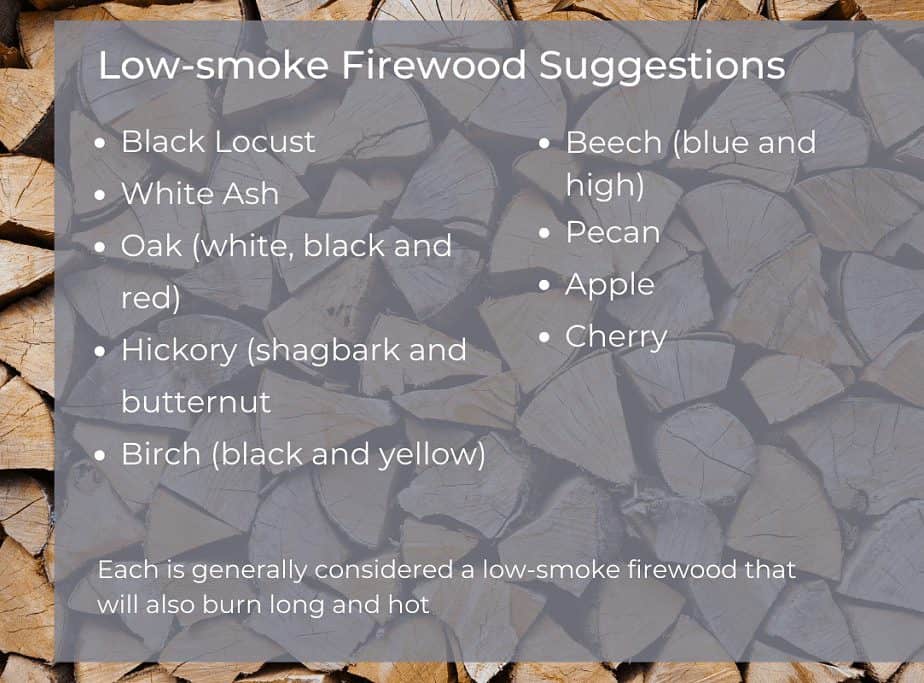
3. Take the Time to Build a Fire That Starts Quickly and Burns Long
Firewood stacking method directly impacts ignition speed and burning efficiency in your fire pit.
That efficiency is a key contributor to keeping smoke from forming and burning it off quickly if it does.
Proper airflow between firewood pieces distinguishes fires that ignite quickly from those that merely smolder and smoke.
I prefer the log-cabin configuration for stability, preventing collapse and hot debris ejection from the fire pit.
Tinder and kindling can be loosely packed in the center at the base for quick and easy ignition.
How to do it:
Stack two pieces of split firewood parallel to each other, about 12″ apart, depending on your fire pit’s size.
Add another row with the same spacing on top, positioning each piece across the ends of the first row.
Stack the wood 3-4 levels high, adjusting based on your fire pit’s size.
Likewise, a tipi stack is another option mentioned prior that is relatively stable and allows for strong airflow between firewood.
How to do it: Stack firewood pieces upward against each other in a circular, cone-like formation. Distribute the pieces evenly to ensure good airflow while maintaining a wide base.
Tinder and kindling are then loosely packed at the base, inside the tipi – also see below.
Check out my article How to Start a Fire Pit for more on the subject.
4. Keep Your Fire Pit Clean After Every Use to Reduce Fire Pit Smoke
Old fire pit debris from previous burns may become damp if exposed to weather, hampering new fire starting.
Building a new fire on top of this debris may inhibit your ability to get a good fire started.
Take a moment to clear your fire pit of all debris after it has completely cooled.
Cover your fire pit, turn it on its side, or store it indoors to prevent water collection and rust formation.
Taking these steps prevents cleaning soggy ash before your next fire and helps you start a strong, smoke-free flame immediately.
5. Consider Using a Smokeless Fire Pit to Drastically Reduce Fire Pit Smoke
Fire pits have evolved from simple bowls with fire rings into sophisticated designs using traditional technology.
What’s the old technology? It’s called a top-lit updraft gasifier or TLUD.
Innovative outdoor companies have adopted this design to create highly efficient fire pits that minimize or eliminate smoke.
In essence, manufacturers build these fire pits with a double-wall structure that employs a unique air circulation system. This design both feeds the fire and burns off excess smoke before it escapes.
The great thing is that these fire pits have been able to deliver on the smokeless claim.
Understand though, smokeless doesn’t mean “no smoke,” just greatly reduced smoke.
You may get a little at the moment when new firewood is added but it usually passes quickly.
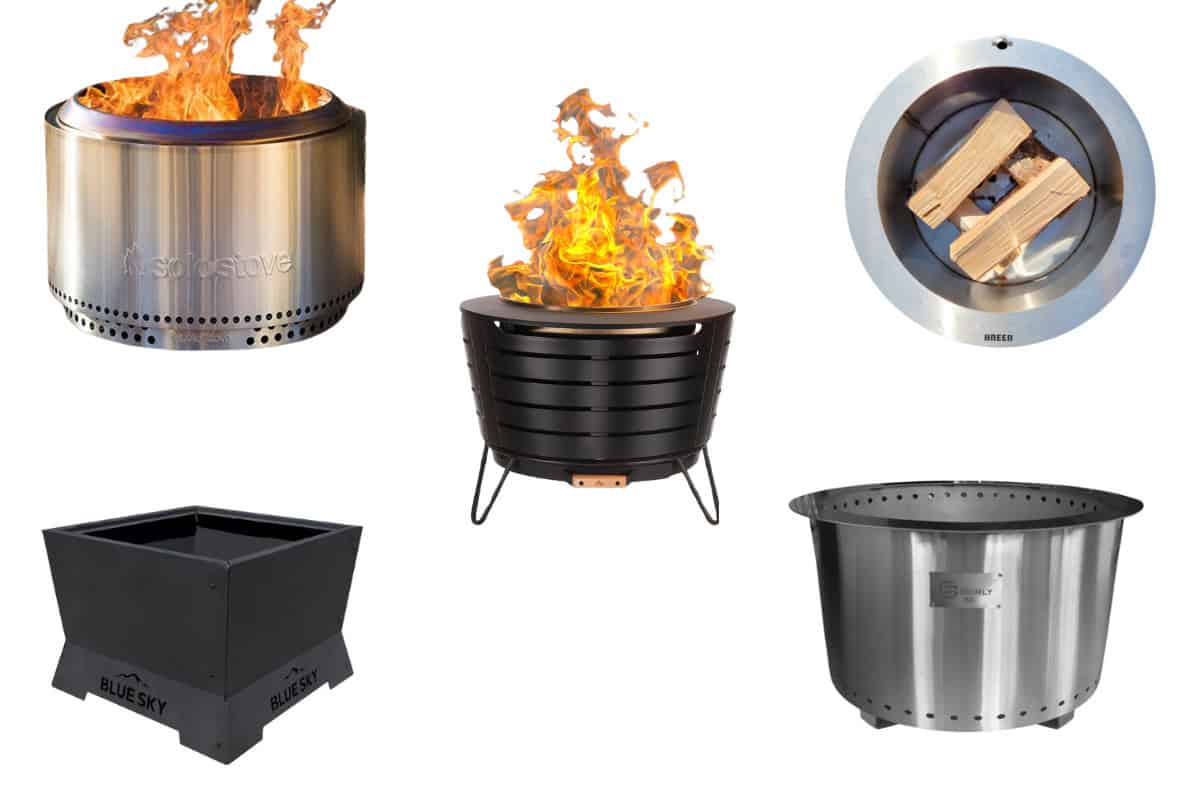
Smokeless Fire Pits: The Current Market
Currently, there are four primary players (in my opinion) in the
All four companies use TLUD in their design and have been pretty successful in carrying the technology over from the industrial market to the recreational side.
Just a few facts about each company and their product lines…
Solo Stove.
- The company formed in 2010, building cooking stoves for campers – currently headquartered in Southlake, Texas, a suburb of Dallas/Fort Worth <— link to Google Maps
- Sought to expand into fire pits in 2016 (their main business was camp stoves prior), working with Kickstarter to raise funds for the venture
- Solo Stove currently offers three fire pit choices to consumers, the Ranger, Bonfire, and Yukon, listed from smallest to largest. <— All links are to solostove.com.
For more on
Breeo.
- The company was formed in 2011 in Lancaster, Pennsylvania. Technically, the company is in Kinzers, just down the road about 15 miles
- Built their first
smokeless fire pit in 2011
- Breeo currently offers three smokeless fire pit options: the Y Series portable smokeless fire pit (21″ diameter), the popular X Series line, in 19″, 24″, and 30″ diameters, and its high-end Luxeve model (33″ diameter). <— all links to Breeo
Tiki.
- Tiki Brand, headquartered in Minnesota, started in the early 1960s and became famous for their iconic torches.
- Built their first smokeless fire pit in 2020
- Tiki Brand currently offers two smokeless fire pit options, its Patio Fire Pit (27.5″ diameter) <— links to Tiki
Flame Genie.
- The company was formed in 1947 in St Louis, Missouri, and builds a variety of products related to residential heat generation and ventilation
- Currently offers one fire pit design in four size/finish configurations; the Flame Genie Inferno in stainless or black powder coat; 13.5″ or 19″) <— link to Amazon
- Flame Genie fire pits are fueled with wood pellets as opposed to regular firewood <—link to Amazon
All fire pits mentioned are considered smokeless by their manufacturers.
While truly smoke-free fire pits don’t exist, smokeless designs dramatically reduce smoke compared to traditional models.
One of the great smokeless fire pit advantages is that they forgive slightly damper wood once burning, efficiently managing smoke with less-than-perfect fuel.
Once you get the fire going, you can add less dry wood later. These fire pits do a surprisingly good job of keeping the smoke down and burning through the wood efficiently.
Finally,

Wrap-up: Reduce Fire Pit Smoke
There’s really not a lot to reducing fire pit smoke. Using well-seasoned dry firewood is going to do the most to move the needle in the right direction.
When choosing firewood, opt for hardwood varieties that produce less smoke for a more enjoyable experience.
Take your time building your fire, making sure to give the fuel space to breathe to prevent smoldering and smoking.
Keep your fire pit clean, dry, and ready to use the next time you decide to fire it up. You’ll get better performing, low-smoking fires, plus your fire pit will not only look better when you aren’t using it, but it will also last much longer.
If you’ve implemented all these smoke-reducing strategies and remain unsatisfied, take the final step and try a smokeless fire pit.
Quality smokeless fire pits are available that work as promised, look attractive, and are reasonably priced.
Take your time and shop around to find one that meets your size and performance needs. I don’t think you’ll be disappointed.
For related content check out our Ultimate Fire Pit Firewood Buyer’s Guide!
Good luck in your battle to reduce fire pit smoke and thanks for reading!
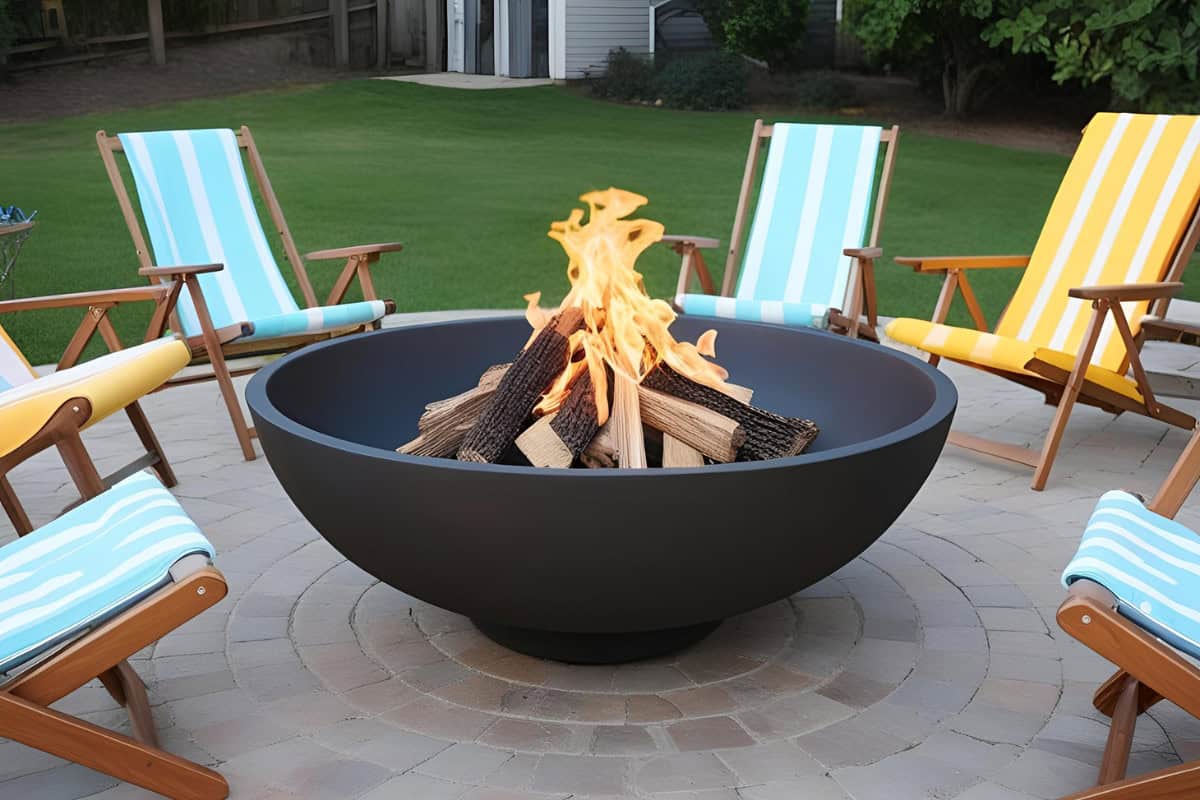
FAQs: Reduce Fire Pit Smoke
A firewood moisture meter is an essential tool for anyone serious about reducing fire pit smoke, with prices ranging from budget-friendly basic models to professional-grade options.
Entry-level moisture meters suitable for casual fire pit enthusiasts typically cost between $20 and $40, offering sufficient accuracy (within 0.5-2% of actual moisture content) to determine whether firewood has properly seasoned below the critical 20% threshold.
Mid-range models ($40-$70) often include additional features like backlit displays, memory functions to track measurements over time, and specialized calibration settings for different wood species, which can be valuable since hardwoods and softwoods have different optimal moisture ranges for clean burning.
For those willing to invest more, premium moisture meters ($70-$150) provide professional-grade accuracy (within 0.1%), temperature compensation for varying climate conditions, deeper pin penetration to measure core moisture rather than just surface levels, and built-in calibration tools for maintaining accuracy over years of use.
When selecting a moisture meter, consider pin versus pinless models—pin types are more accurate for firewood applications as they measure moisture at depth where it matters most for combustion performance, while popular brands like General Tools, Dr. Meter, and Klein Tools consistently receive positive reviews for reliability and accuracy in the $25-$35 price range, making them ideal starting points for most homeowners looking to significantly reduce fire pit smoke through proper wood selection.
Wood pellets are a highly efficient alternative fuel source for fire pits that can dramatically reduce smoke issues while maintaining an enjoyable fire experience.
Unlike traditional firewood, wood pellets are manufactured by compressing sawdust and wood waste materials into small, cylindrical pieces typically measuring 1/4-inch in diameter and about an inch long through a process that removes nearly all moisture content (typically below 10%).
This uniformity and extremely low moisture level results in a remarkably clean burn with minimal smoke production compared to even the best-seasoned traditional firewood.
In the fire pit context, specialized pellet fire pits like the Flame Genie use these compressed wood cylinders exclusively, creating an almost smoke-free experience while still delivering substantial heat output and attractive flames.
The consistent size and composition of pellets create predictable burning characteristics that eliminate the variability common with natural logs, while their dense nature means they burn longer per pound than traditional firewood.
For fire pit enthusiasts concerned about smoke affecting their outdoor gatherings, wood pellets offer several advantages beyond smoke reduction: they’re easier to store in limited spaces, remain unaffected by humidity when properly stored, light quickly with minimal kindling, require no seasoning time, produce significantly less ash for easier cleanup, and are widely available at hardware stores, home improvement centers, and outdoor retailers at competitive prices compared to premium kiln-dried firewood.
Yes, there are specialized smokeless fire pit inserts designed specifically for installation within existing stone block, brick, or masonry fire pit surrounds.
These inserts utilize the same double-wall technology found in standalone smokeless fire pits but come in forms that can retrofit traditional masonry installations.
Companies like Breeo offer dedicated inserts like their X Series with patented Outflow™ technology that can be dropped into existing masonry fire pits to dramatically reduce smoke production.
These inserts feature strategically positioned air intake channels at the bottom and secondary combustion holes near the rim that create the efficient airflow patterns needed for smokeless operation.
When selecting a smokeless insert for a brick or stone fire pit, you’ll need to measure your existing fire pit’s interior dimensions carefully, as most inserts require specific clearances for proper airflow around all sides.
Installation typically involves removing any existing fire ring or bowl, ensuring proper drainage at the base, then placing the insert so it sits securely with its rim slightly above the masonry surface.
Some manufacturers offer custom sizing options to fit non-standard dimensions, though these typically come at a premium price.
While these inserts represent a higher initial investment than standard fire rings (ranging from $300-$1200 depending on size and features), they offer the perfect compromise between preserving your permanent stone or brick fire pit’s aesthetic appeal and eliminating the frustration of smoke constantly chasing your guests around the fire.

